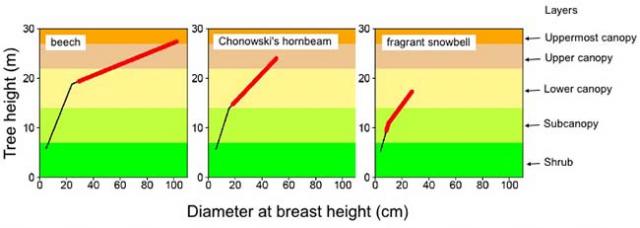Home > Research > Research Results > Research Results 2020 > When and why does tree height growth begin to slow down? The importance of reproductive onset
Update:April 6, 2020
Main content starts here.
When and why does tree height growth begin to slow down? The importance of reproductive onset
| Article title |
When and why do trees begin to decrease their resource allocation to apical growth? The importance of the reproductive onset |
|---|---|
| Author (affiliation) |
Maki Suzuki (a), Kiyoshi Umeki (b), Olga Orman (c), (d), Mitsue Shibata (e), Hiroshi Tanaka (e), Shigeo Iiida (f), Tohru Nakashizuka (g), Takashi Masaki (e) (a) The University of Tokyo, Kashiwa, Chiba, Japan. (b) Chiba University, Chiba, Japan. (c) Kyoto University, Kyoto, Japan. (d) University of Agriculture in Kraków, Kraków, Poland. (e) Department of Forest Vegetation, FFPRI, Tsukuba, Ibaraki, Japan. (f) Kyushu Research Center, FFPRI, Kumamoto, Japan. (g) Research Institute for Humanity and Nature, Kyoto, Japan. |
| Publication Journal |
Oecologia, 191(1):39–49, September 2019 DOI:10.1007/s00442-019-04477-y |
| Content introduction |
Even though height increases with increasing diameter in juvenile trees, height growth slows down after a certain stage. There have been various suggestions to elucidate the underlying causes, including either difficulty in drawing water to high branches or structural changes to support high growth; however, these are insufficient to completely explain such slowing down of height growth. To examine another possibility that whether the slowing down of height growth is concurrent with the onset of flowering and fruiting, we measured the diameter and height of 400 trees of 13 species and studied the height at which each species begins to display more than a certain amount of flowering and fruiting. The results showed that most of the species that we investigated displayed a breakpoint when the tree exceeded a certain diameter and height growth slowed down. This breakpoint corresponded approximately with the tree height at which stable flowering and fruiting began. Since this point was located in the canopy in most species, it appears that the change in environment when the top of a tree reaches the canopy triggers a change in growth strategy that diverts energy to flowering and fruiting, resulting in less energy being used for height growth. Exceptions to this rule were the small tree species, such as fragrant snowbell (Styrax obassia) and grey-budded snakebark maple (Acer rufinerve), which showed breakpoints at the subcanopy layers. These trees can be said to have a growth strategy in which flowering and fruiting are initiated while they are still small without regard for the future. In the present study, for the first time to the best of our knowledge, we could provide concrete data supporting the fact that a slowing down of tree growth is correlated with flowering and fruiting. The results of this study will be of value in designing structurally complex forests of multiple species.
Figure 1. The graphs illustrate the relationship between diameter at breast height (DBH) and tree height. The red line indicates that the species exhibits more than a certain amount of flowering and fruiting. Most of the tree species had a breakpoint when the tree exceeded a certain diameter and height growth slowed down. The left-hand and middle graphs depict a canopy tree species reaching their breakpoint at nearly the same time as they reach the canopy, while the graph on the right depicts a small tree species reaching its breakpoint before reaching the canopy. |
Copyright © Forest Research and Management Organization. All rights reserved.

